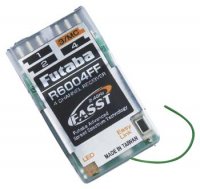I owned a DX7 and a JR X9303. I liked both radios and prefered the JR. In my first airplane with the DX7, I mistakenly used a 4 cell NiCad and I payed the price for it. After that, I only used 6v batteries and never lost another airplane to a "brown out" or a lost link. However, I always made dang sure my batteries were well charged before I flew, and I even purchased a battery checker that would provide a load to the battery to make dang sure the battery was good before each flight.
But, when I decided to start flying bigger planes, 30, and 50cc airframes...I decided to make the switch to a Futaba 8FGs. I did this for two reasons, one fore programming ease, and the second for piece of mind. I still constantly check my voltage, but I have felt much more connected to my airplanes since the switch.
As an example for programming:
I purchased a GP Reactor which uses 2 servos for each aileron, 1 for each side of the elevator, 1 for rudder, and 1 for throttle. 8 servos total. With the X9303 I could not program the aileron servos without either a Y harness, which I loath, or a match box. I had not yet purchased my 8FG, so I utilized a match box for one side. The programming took me approximately 1 hour to complete. Do not get me started on the pain in the butt extra satellites....
Anyway, when I got the 8FG in, I installed a 14 channel receiver and opened up the manual. 20 minutes later, incuding the time it took to read the manual, I was done and ready to head to the flying field.
The 8FGs is butter smooth and the programming is amazing. It takes a bit to learn, but so does anything new. I love being able to assign my own channels, and name my own switches. I do miss the BNF micros sometimes, but it was a small price to pay for the quality and ease of use I gained.
I don't like the low volume alarm, but I have trained myself to raise up my radio so that I can view the timer and keep an eye on my airplane. I learned to do that with my JR, and when I first began flying, 12 years ago I used my radio to block the sun when I was dumb enough to fly "through" it. Most of the time, I keep a cheap 99 cent timer in my radio box that is louder than Rosanne Barr and I just clip it to my shirt pocket.
But, when I decided to start flying bigger planes, 30, and 50cc airframes...I decided to make the switch to a Futaba 8FGs. I did this for two reasons, one fore programming ease, and the second for piece of mind. I still constantly check my voltage, but I have felt much more connected to my airplanes since the switch.
As an example for programming:
I purchased a GP Reactor which uses 2 servos for each aileron, 1 for each side of the elevator, 1 for rudder, and 1 for throttle. 8 servos total. With the X9303 I could not program the aileron servos without either a Y harness, which I loath, or a match box. I had not yet purchased my 8FG, so I utilized a match box for one side. The programming took me approximately 1 hour to complete. Do not get me started on the pain in the butt extra satellites....
Anyway, when I got the 8FG in, I installed a 14 channel receiver and opened up the manual. 20 minutes later, incuding the time it took to read the manual, I was done and ready to head to the flying field.
The 8FGs is butter smooth and the programming is amazing. It takes a bit to learn, but so does anything new. I love being able to assign my own channels, and name my own switches. I do miss the BNF micros sometimes, but it was a small price to pay for the quality and ease of use I gained.
I don't like the low volume alarm, but I have trained myself to raise up my radio so that I can view the timer and keep an eye on my airplane. I learned to do that with my JR, and when I first began flying, 12 years ago I used my radio to block the sun when I was dumb enough to fly "through" it. Most of the time, I keep a cheap 99 cent timer in my radio box that is louder than Rosanne Barr and I just clip it to my shirt pocket.

